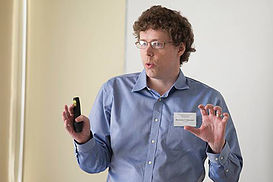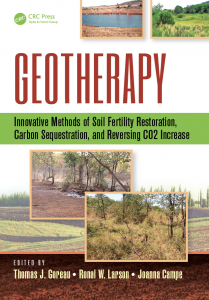Explore Geotherapy with the Remineralize the Earth Geotherapy Blog

Benjamin T. Rancourt, RTE Science Editor, presenting at a conference at Tartu University in Estonia.
Welcome to the Remineralize the Earth’s Geotherapy Blog, a resource of news, reviews, and information about geotherapy. Geotherapy is a down to earth, effective approach to addressing the climate crisis. It emphasizes addressing the source of the problem, and it focuses on existing techniques that have already been shown to work. This blog is a companion to, and extension of, the book Geotherapy: Innovative Methods of Soil Fertility Restoration, Carbon Sequestration, and Reversing CO2 Increase (edited by Thomas J. Goreau, Ronal W. Larson, and Joanna Campe; published by CRC Press), which details ways that healthy soil can serve as a key tactic to address climate change. Soil is a complex, living system that is an important carbon sink, in addition to being a source of nutrients for plants.[1]
In addition to stabilizing the climate, geotherapy encompasses techniques to increase crop yields, improve crop nutrient density, restore forests, and encourage greater biodiversity. Not satisfied with dreaming of an ideal world, the book covers techniques which are not only effective and available today, but are also economically and politically viable. The growing body of information about geotherapy will be vital in the coming years as we face the growing challenge of climate change and environmental degradation.[2]
One of the most successful techniques for cost-effectively improving agriculture and the environment is soil remineralization using rock dust and marine minerals. Remineralization is a low tech (it just uses crushed rocks and sea-based products), low cost, environmentally friendly solution that has been shown—in research stretching back over a century—to dramatically improve soil health. As you will see in the pages of this blog, and as covered in rigorous detail in Geotherapy, remineralization has been used all over the world—from Mexico to Brazil, from Senegal to Cameroon, and the United States and elsewhere—to produce real results for farmers, forests, and the environment.
Biochar is another promising avenue of improving the soil of the world. Biochar is a low-tech carbon charcoal that serves as a beneficial soil additive. In addition to its demonstrated effect on plant growth, it is by itself another way of sequestering carbon dioxide in the soil. Incorporating biochar with remineralization presents an opportunity to address failing soil health.
Biochar functions in the soil as a coral reef functions in the ocean, creating the perfect habitat for nutrients and microorganisms, while remineralization adds minerals that feed the microorganisms and are taken up by the plants. We envision the potential to create perpetually fertile soils like terra preta (black earth) in the Amazon region [reference].
In concert with other projects, remineralization and biochar are low cost, easily implemented strategies to improve soil health, leading to increased crop yields, higher nutrient density, and greater biodiversity. This helps address climate change, overuse of natural resources, and other issues. This is the essence of geotherapy.
Geotherapy differs from geoengineering, a more radical approach to climate change that has unfortunately garnered much more attention. Geoengineering proposes massive engineering projects using untested technologies, such as giant space mirrors to reflect the sun or man-made chemical clouds in the atmosphere, to address environmental/food problems. Geoengineering is expensive and difficult, and there is no way to tell whether it will help or cause more damage to the planet. We should not neglect the safe, effective tools that geotherapy already provides, because geotherapy is committed to stewardship through imitating the Earth’s own natural cycles and processes.
This blog will be dedicated to geotherapy. It will include summaries and reviews of chapters of the book, news about the central topics, reflections on the successes and challenges ahead, as well as guest posts by scientists, researchers, farmers, and volunteers working in a variety of fields. We will keep you up to date with the impact of this approach. I hope you follow along and learn about this important aspect of the movement to rehabilitate the Earth.
Benjamin T. Rancourt received his PhD in Philosophy from the University of Massachusetts Amherst in May 2016. His continuing philosophical research focuses on understanding, knowledge, and science, among other topics. This research ties into his wider goal of encouraging deeper understanding of ourselves, our strengths, and our limitations. He hopes that greater understanding will help us use the resources available to us to preserve what is good and address what is wrong. Walking is his primary mode of transportation. He appreciates the natural world. He lives in Northampton, Massachusetts with his wife Julia.
[1] The 34 chapters of Geotherapy present the theoretical foundations, experimental support, and real-world application of geotherapy as an approach to agriculture and reforestation. [2] This is especially urgent given that organizations tasked with addressing climate change have neglected the important role of soil (e.g. the United Nations Framework Convention on Climate Change).
Support us on Patreon
Thank you for joining us today! Please become a member of RTE and support us on Patreon. Unlike many larger organizations, we work with a team of determined and passionate volunteers to get our message out. We aim to continue to increase the awareness of remineralization to initiate projects across the globe that remineralize soils, grow nutrient dense food, regenerate our forests’ and stabilize the climate – with your help! If you can, please support us on a monthly basis from just $2, rest assured that you are making a big impact every single month in support of our mission. Thank you!









bret merideth
August 5, 2016 (3:47 pm)
What type of rock/stone dust is best/ easiest to get in bulk from my local gravel pit? Are certain rocks better than others? I live in Indiana.
Joanna Campe
February 20, 2017 (9:18 pm)
Please download the rock dust primer from our website for this information.